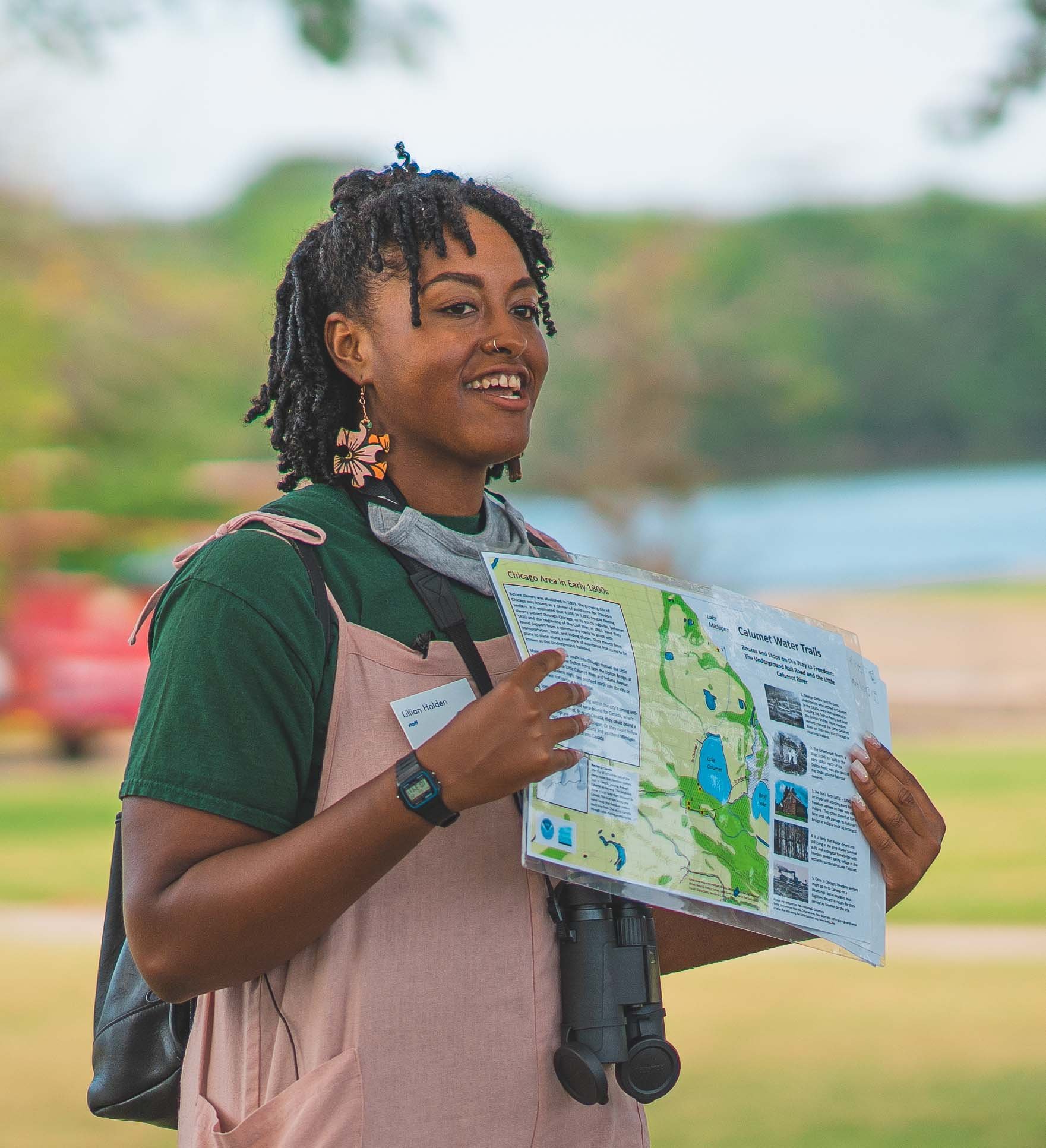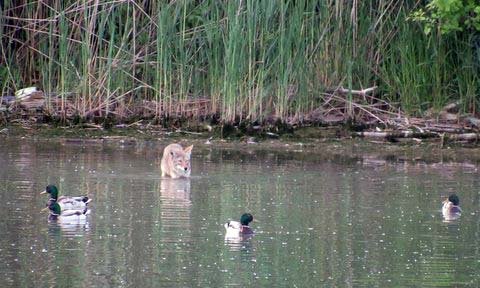Paddler heads west on the African American Heritage Water Trail from Beaubien Woods. Photo by Rudy Schultz.
By Susan Messer
Lake Michigan, one of Chicagoland’s great treasures, is connected to the Mississippi River by a series of waterways, including the Little Calumet River, which flows through several south-side Chicago neighborhoods, carrying nearly two centuries of African American history. The African American Heritage Water Trail honors this history and the remarkable stories of African American freedom seekers and trailblazers who traveled, lived, worked, and overcame enormous obstacles around this river and its banks. Please stop right now and visit this beautiful website, where you’ll find everything you need to understand the trail and the stops along its way.
To learn more, of course, you’ll need to paddle the trail. But in the meantime, here I present parts of the conversation I had with two Openlands staff members who helped bring this water trail to life: Laura Barghusen, blueways director, who works with governments and communities to connect people to the waterways of northeastern Illinois, and Lillian Holden, education and outreach coordinator, who works with volunteers, teachers, and staff to build and inspire advocates for nature.
Laura Barghusen. Photo by Lucia Whalen.
Here’s what I learned: The idea for a system of publicly accessible water trails for canoeing and kayaking in the Chicago region began in the 1990s, with the goals of attracting people to the waterways, enhancing stewardship, improving quality of life and educational opportunities, and spurring economic development. The Little Calumet was part of the Underground Railroad as well as a backdrop for many nationally and even internationally significant African American achievements years afterward, including the launch of the environmental justice movement. Says Barghusen, "If [people] did have an idea of that history, it would help them value the Little Calumet River more and attract them to it."
Organized by the Forest Preserves of Cook County, a series of planning meetings in 2018 led to the idea of creating the African American Heritage Water Trail on the Little Calumet, with the goals of elevating these important stories, engaging stakeholders, and better connecting neighborhoods immediately west of Beaubien Woods to the Little Calumet River. Openlands worked with historians, community groups, and others to create a brochure and map for the water trail. The brochure was printed in spring 2020.
Lillian Holden of Openlands discusses the historical significance of the trail at an African American Heritage Water Trail event. Photo by Rudy Schultz.
Holden became involved in July 2020, doing research about the places along the trail, deciding which to highlight, creating a document that laid out the themes and talking points that interpreters and expert paddling guides could use to lead river tours and bring positive attention to the assets of the river and the neighborhoods along its banks. In the summer of 2020, Openlands finished a story map that provides information about every stop on the trail, but the pandemic kept them from offering any paddling tours until summer/fall 2021. They and their partners—including Friends of the Chicago River, the Forest Preserves of Cook County, and Wilderness Inquiry, as well as several community groups—are currently planning programming for next year.
Holden is also a champion for the Birds in my Neighborhood program, a project that introduces children in grades 2-5 to nature in their own communities. “Now,” she said, “I can bring that [bird watching] lens into the water trail. The Little Calumet is very rich with water fowl, with song birds. I’ve seen cormorants there, kingfishers, bald eagles, hawks. Osprey. I tell the groups before they get into the canoes, ‘There’s going to be birds. Don’t be afraid to look around.’”
Barghusen tells me about the conservationist efforts underway to allow birds to thrive despite a history of contamination in the water and in the fish that inhabit it, and despite habitat loss. “One theme of the trail is environmental quality,” she says, “and we can tell that story through the birds.”
Neither of these two consider themselves to be expert paddlers, but both now feel more confident on the water, especially because of the expert guides. “This particular trail is a big channel, with power boats and barges,” says Barghusen, “so I don’t recommend that people do it on their own unless they are experts.
The first event on the water trail, held in August 2021 and led by Friends of Chicago River, featured paddling guides and two-to-three-person canoes. The second event, in September 2021, featured eight-person canoes from the nonprofit Wilderness Inquiry, with a guide in each canoe. The events are designed for beginners, with safety in mind.” Holden agrees: “I consider myself a novice paddler, so having experts around is essential, to tell you what to do if you go off course, to teach you ways of communicating with your paddle partner in the two-person canoes.”
More paddlers head west on the African American Heritage Water Trail from Beaubien Woods. Photo by Rudy Schultz.
It’s so worth it, she says: “It has been a huge prize to be able to work on a subject like this, a region with such rich history. I had my lightbulb moments, about what American history is, depending on who’s telling it, who’s highlighting what’s in the history. Like the reference to the Green Book. We highlight that in relation to the Western Avenue Bridge in Blue Island, which was part of a network of roads that took travelers south to Miami. It’s an important part of American history, and the trail doesn’t shy away from the truth of how African Americans were forced to engage in American culture. Also, this was my first time being aware of the Underground Railroad in the area.“ She goes on: “I’m canoeing along this river where someone from my ancestry, my heritage, went through that track from south to north. I felt a sense of pride. It left a tender spot in my heart.”
Laura, too, felt moved by her experience: “We’d been collecting the stories for the trail before I paddled on it for the first time, so I simply didn’t realize how beautiful it was going to be. That first time, we put our canoes in at the Beaubien Woods boat ramp—I’d always thought of it as an industrial channel—but there we were, paddling west, and when we came to the fork between the Little Calumet River and the Cal-Sag Channel, the beauty almost knocked me over. A whole group of cormorants landed on the water in front of us. It was awe-inspiring. And then, of course, we were learning the history—the stop on the Underground Railroad, the history of the Village of Robbins. I learned so much, and it was all so unexpected. We’re hoping this trail will elevate the history in people’s minds and point out how unique and important this corridor of the river is. We’re hoping to engage local youth in learning to interpret the trail. We want it to bring pride and economic opportunity to the area. Looking forward, we’d like to have art installations along the trail to commemorate the history, to give visitors even more to see.”
A coyote wades into the water after ducks near Beaubien Woods. The water trail presents great opportunities to see wildlife. Photo by Ders Anderson.
And Lillian’s hopes for the trail? “I’d like it to be a guide for people from many racial backgrounds and ethnicities to understand and embrace America’s history from the perspective of the Black experience. I shared the tour with my family members, and I saw them have the same kind of lightbulb moments I had—even my aunties, who have been around way longer than I have. I want this to be a multidimensional experience for people who come to the trail. We’ve created a sacred place and a deep connection to our heritage.”





